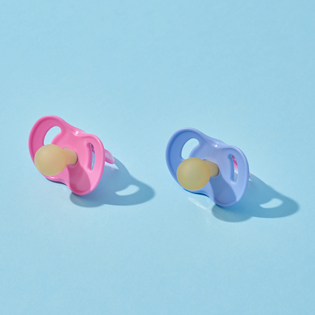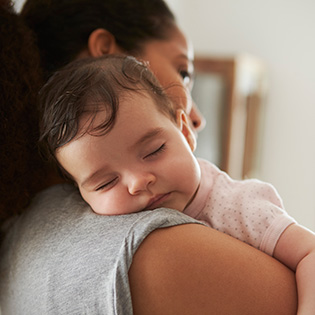In a perfect world you'd never need to save your child's life. But accidents and emergencies happen, even with the most vigilant parent. Babies and toddlers can choke on pieces of food or small toys or even get tangled in curtain cords. Luckily, by taking classes on infant and children's CPR (short for cardiopulmonary resuscitation), you'll learn to handle many emergency situations yourself.
In a class, you'll learn the proper techniques for rescue breaths, chest thrusts, back blows and more. These moves can get the heart and lungs to work after a life-threatening trauma or injury.
The other advantage of taking a class? You'll get experience practicing — and studies have shown that the more people practice, the more confident they are in a true emergency.
Just remember that the steps for both the Heimlich maneuver and CPR differ for infants and kids who are over a year old, so make sure to get a refresher once your child turns 1.
How to do infant CPR
Even though hands-only CPR is now recommended for adults, rescue breaths are still recommended for infants. Follow these steps for babies 12 months and under only:[1]
- Check to see if your baby is responding. Call her name or tap the soles of her feet. If your baby responds, don't start CPR. But if she's stopped breathing, start CPR.
- Have someone call 911, if you're with another adult (or a school-aged child).
- Place your baby on her back on a firm, flat surface (not on a bed). Stand or kneel next to the baby with your hips at an angle.
- Give her 30 chest compressions. Quickly remove (or open) clothes from your baby's upper body, and place both thumbs side by side just below an imaginary horizontal line running between your baby's nipples. (Make sure not to press down at the very end of the breastbone.) Give 30 chest compressions with those two thumbs very quickly — at a rate of 100 to 120 beats per minute (about two compressions per second). Count out loud to 30. Each time, press your baby's chest straight down about 1.5 inches. After each chest compression, release pressure on the chest to let it come back to its normal position.
- Give two breaths. Gently tilt your baby's head back. Push back on her forehead and lift her chin up with one finger by pressing underneath the bony part of the chin. Then, put your mouth over her mouth and nose, and give two breaths lasting one second each. Watch for her chest to rise as you give each breath. If the chest doesn't rise, there may be an object blocking the airway.
- Repeat compressions and breaths. Repeat the cycle of 30 chest compressions and two breaths (30 chest compressions and two breaths equals one CPR cycle). Every time you stop to give breaths, open the baby's mouth wide and look for an object, which might have dislodged. If you see an object, remove it with a sweep of your finger. If you do not see an object, keep giving sets of 30 chest compressions and two breaths. If you're alone and no one has called 911, after five cycles of CPR (two minutes), call 911 yourself.
- Keep giving 30 chest compressions and two breaths, until the baby starts to move and breathe on her own or help arrives.
How to do the Heimlich maneuver on infants
Here's what to do if a baby 12 months and under is choking but still conscious:[2]
Read This Next
- Hold your infant face down on your forearm, so that her head is lower than the rest of her body. (Sit or kneel and rest your arm on your lap or thigh for support.) Support your baby's head and neck with your hand. Don't cover her mouth or twist her neck.
- Give up to five quick back slaps between your baby's shoulder blades with the heel of your free hand.
- Turn the baby face up. If the object doesn't pop out after five blows, turn your baby onto her back along your forearm (still using your lap for support). Remove or open her clothes (if you can do that quickly), support the back of her head with your hand, and keep her head lower than the rest of her body.
- Give her up to five quick chest thrusts, placing your index and middle fingers just below an imaginary horizontal line running between your baby's nipples. If your baby is too heavy to lay her on your forearm for the chest thrusts, you can also lay her flat on her back, but you should try to position her so that her head is still lower than her body.
- Alternate five back blows and five chest thrusts, if the object still doesn't come out. Do this until the object comes out and your baby can breathe, cough or cry, or until help arrives.
- If your baby loses consciousness, start infant CPR (above).
How to do toddler CPR
The CPR procedure for children over 12 months old is slightly different than that for babies. And even though hands-only CPR is now recommended for adults, rescue breaths are still recommended for small children. Here's what to do:
- Check to see if your child is responding. Call her name, tap the soles of her feet or gently shake her shoulder. If she responds, don't start CPR. If she doesn't, you can start CPR after checking for breath sounds.
- Have someone call 911, if you're with another adult (or a school-aged child).
- Place your child face up on a firm, flat surface (not a bed), and kneel next to the child.
- Give 30 compressions. Quickly remove clothes from the chest, and put the heel of one hand on the center of your toddler's chest between the nipples. If the child is older (or larger), you may need to put the heel of your other hand on top of the first hand. Give 30 chest compressions at a rate of 100 to 120 beats per minute (about two compressions per second). Push straight down about 2 inches while keeping your arms straight and under your shoulders. After each chest compression, release pressure on the chest to let it come back to its normal position.
- Give two breaths. Push back on her forehead, and lift the child's chin up by putting your fingers underneath the bony part of the chin. If your toddler isn't breathing, pinch her nose closed, cover her mouth with your mouth, and gently give two breaths lasting one second each. Watch for her chest to rise as you give each breath. If the chest doesn't rise, there may be an object blocking the airway.
- Repeat compressions and breaths. Repeat the cycle of 30 chest compressions and two breaths. (One CPR cycle equals 30 chest compressions and two breaths.) Every time you open the airway to give breaths, open the child's mouth wide and look for the object, which might have dislodged. If you see an object, remove it with a sweep of your finger. If you do not see an object, keep giving sets of two breaths and 30 chest compressions. If you're alone and someone else has not called 911, after five cycles of CPR, call 911 yourself.
- Keep giving 30 chest compressions and two breaths, until the child starts to breathe on her own and move or help arrives.
How to do the Heimlich maneuver on toddlers
For children over 12 months who are choking and conscious, here's what to do:
- Kneel or stand behind your toddler, bend your child over at the waist and administer five quick slaps between the shoulder blades with the heel of your hand.
- Wrap your arms around her, so that your hands are in front of her chest.
- Make a fist with one hand, putting the thumb side of your fist slightly above the toddler's belly button and well below the breastbone.
- Deliver thrusts. Grasp your fist with your other hand, and give five quick inward and upward thrusts into her belly until the object is forced out. Use less force than you would on an adult or older child.
- Alternate back slaps and thrusts until the object comes out and your toddler can breathe, cough or talk.
- If your child loses consciousness, start CPR for children (above).
How to find first aid classes for babies and toddlers
To find an infant or children's CPR class near you, visit the American Heart Association class locator or the American Red Cross class locator. You can also find a class through your local hospital or log on to ShopCPR to order a home-based infant or children's CPR course that comes with a practice mannequin — and includes instructions on choking relief. BabyCenter also offers a virtual course for infants.











































 Trending On What to Expect
Trending On What to Expect





